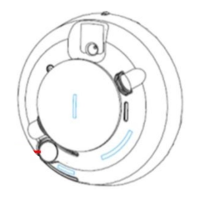
Do you have a question about the SMC Networks SMCSM10-Z and is the answer not in the manual?
| Brand | SMC Networks |
|---|---|
| Model | SMCSM10-Z |
| Category | Smoke Alarm |
| Language | English |
Guides installation per NFPA standards, considering structure, contents, occupancy, and area.
Factors for choosing location: structure use, contents, occupancy, area, ceiling height, air movement, obstructions.
Suggests locations based on temperature, humidity, ventilation, and proximity to bathrooms.
Step-by-step guide for removing and installing batteries, emphasizing proper polarity and battery type.
Instructions on removing the dust cover from new products for protection in dusty environments.
Explains the unique ID programmed at manufacture and enrollment into the Touchscreen.
Detailed steps to pair the SMCSM10-Z with the Touchscreen via the Settings menu.
Procedure to test communication between the Touchscreen and SMCSM10-Z before permanent mounting.
Steps for attaching the mounting base and then securing the SMCSM10-Z to the base.
Describes normal operating mode (Status LED flashes) and alarm mode (red Status LED ON).
Details Trouble/Maintenance Mode (LED OFF) and Battery Replacement Mode (LED OFF, chirps).
How to silence the alarm using the Test button, noting it may resume if smoke persists.
Pressing the Test button sends a signal to the Touchscreen for verification.
Setting the Touchscreen to test mode to prevent central station alarms and testing via button press.
Procedure for testing with simulated smoke (e.g., Smoke! in a Can®).
Procedure to enter diagnostic mode via the Test Button, with LED flash meanings for sensitivity and faults.
Step-by-step instructions for cleaning or replacing the smoke chamber, including notifying the monitoring station.
Troubleshooting steps for no power or low battery issues, checking battery seating and voltage.
Steps to resolve Touchscreen non-response, checking link and enrollment with the Touchscreen.
How to resolve tamper condition issues, checking installation, mounting plate, and trouble indications.
Steps to restore alarm/open conditions, checking smoke clearance and Touchscreen compatibility.
Defines complete coverage requirements for all spaces, excluding inaccessible areas.
Requirements for partial detection systems in common areas and work spaces.
Mandates protection of selected areas only, as required by jurisdiction.
Guidelines for non-required detection conforming to code requirements.
Requirements for installing heat-sensing fire alarms where mandated by codes or authorities.
Installation requirements for single-station smoke alarms in new and existing apartment buildings.
Information on product disposal (WEEE) and compliance with hazardous substance restrictions (RoHS).
Lists UL/CAN/ULC standards, FCC ID, IC, and compliance statements for radio frequency devices.
Explains the role of smoke alarms in early fire detection and occupant safety.
Lists precautions to avoid fire hazards, such as not smoking in bed or leaving children unattended.
Instructions for immediate evacuation, staying low in smoke, and checking doors for heat.
Steps for preparing family for fire events, including drills, escape plans, and meeting points.
